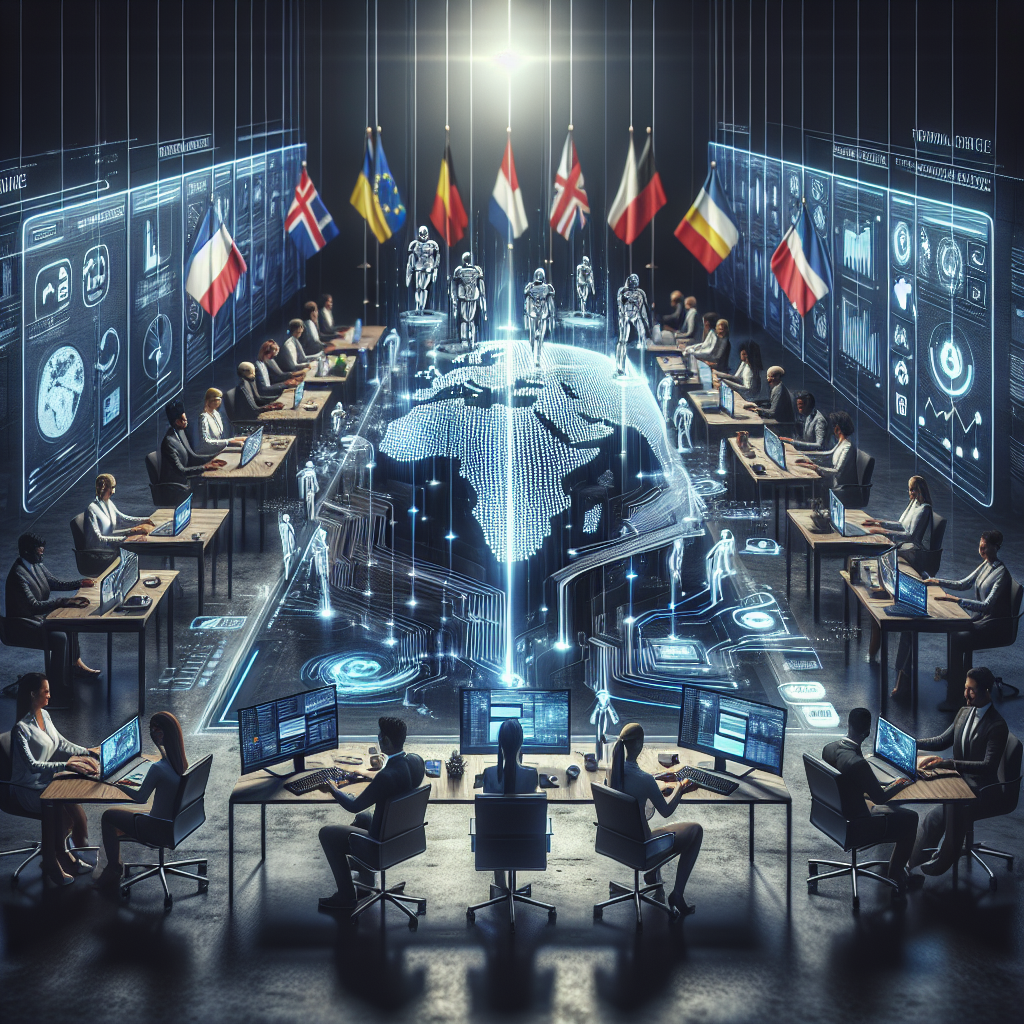About eldris
Clone.Eldris.ai empowers brands to instantly replicate and translate their websites for seamless global expansion. Our automated system delivers SEO-friendly, multilingual clones that launch in days, not months.
In This Article
- Automated translation offers unmatched speed and scalability, critical for large product inventories and time-sensitive launches.
- Manual translation provides cultural nuance and legal accuracy, ideal for sensitive or brand-critical content.
- A hybrid approach combines efficiency with quality, especially when supported by post-editing workflows and automation tools.
- Shopify and modern CMS platforms natively support integration with translation engines, improving workflow efficiency.
- Regulatory compliance and cultural localisation are non-negotiable in the European Union and must guide your translation strategy.
Why Translation Matters in European E-Commerce
Cross-border barriers and customer experience
With 24 official languages spoken across the EU and countless local dialects, reaching a wider audience in European e-commerce necessitates precise and accessible translation. Accurate product information in a shopper’s native tongue not only improves trust but directly influences buying behaviour. Inaccurate or out-of-context translations, however, result in confusion, abandoned carts, and lost revenue.
Is Automated Translation the Superior Choice for E-commerce?
Localisation goes far beyond mere word-for-word conversion; it involves adapting the language to reflect cultural nuances, local regulations, and buying preferences. Automated translation has emerged as a potential solution to rapid multilingual demand, especially as brands expand into new regions. Whether your target market is Spain, France, Poland or the Baltics, delivering an excellent user experience in the customer’s preferred language cannot be overlooked.

Automated Translation: Unmatched Scalability in Seconds
How AI powers instant multilingual deployment
Automated translation leverages artificial intelligence and machine learning models, such as those built on neural machine translation (NMT) frameworks. These systems can translate entire websites, product catalogues, and communications within seconds, regardless of the volume. The scale at which these tools operate transforms the localisation landscape for e-commerce businesses with thousands of SKUs or extensive user-generated content.
Scaling Online Store Translations Across Europe: Strategies and Tips
One of the primary advantages of automated translation is its ability to maintain consistency across a broad content set. It recognises terminology, applies consistent grammar rules, and learns over time. This makes it particularly favourable for translating ecommerce metadata, navigation elements, product descriptions, and FAQs. For platforms that rely on real-time updates or have short product lifecycles, manual translation simply cannot keep up.
Incorporating automated translation into platforms such as Shopify or headless CMS solutions allows for real-time, multilingual website generation—critical in flash sales or global product launches. These efficiencies free up human resources, accelerating global expansion strategies while controlling costs. To understand practical implementation, explore Learn more about E-commerce Localization Strategies. That guide offers an in-depth technical breakdown of integrating translation APIs across platforms.
“In a digital-first economy, scalability is non-negotiable. Automated translation provides the velocity needed to win cross-border markets without compromising launch timelines.”
Manual Translation Explained: Human Precision
While automated translation unlocks speed and scale, manual translation remains the benchmark for linguistic accuracy and cultural depth. Professional translators possess the contextual awareness and industry-specific knowledge that machines often lack. Their input is invaluable for legal documents, brand storytelling, and complex marketing content where tone and subtext are essential.
Weighing the Pros and Cons: Machine Translation vs Human Translation
When communicating with high-ticket audiences or regulated industries, human translators understand stylistic expectations, idiomatic expressions, and culturally appropriate phrasing. For example, translating a luxury brand’s slogan from English into German involves not just grammar, but evoking the same emotional resonance. Human editors are also skilled at identifying inconsistencies, ensuring the translated content aligns with your brand’s voice and regulatory obligations.
Despite their strength in quality, human translators face limitations in speed, cost, and availability. Even the most experienced professionals require time and access to context. This introduces delays in content publishing cycles and increases operating costs, particularly when working across multiple languages simultaneously. As such, knowing when and where to deploy manual translation is crucial to controlling project scope and spend.
Cost Comparison: AI vs Professional Translators
Cost is one of the clearest differentiators between automated and manual translation. Traditional translation agencies typically charge per word or per hour, depending on the complexity of content. Rates vary drastically—technical documents or rare language pairs command a premium. By contrast, AI-based translation services such as Google Translate, DeepL, or integrated translation engines in platforms like Weglot offer subscription-based or per-character pricing models that reduce costs significantly for high-volume content.
Determining the Fastest Translation Method for E-commerce Websites
For ecommerce businesses operating in 10+ countries, the budget required for professional translation of thousands of SKUs becomes prohibitive. At scale, automated translation offers an ROI that manual methods cannot match. However, this cost-saving must be balanced with quality assurance processes to avoid reputational risks caused by poor translation.
A hybrid model—combining the initial speed of automated translation with professional post-editing for critical content—often strikes the best balance. This strategy supports budget optimisation while safeguarding brand reputation across borders. For further savings strategies and automation recommendations, see Read a related article.
Maintaining Quality: Accuracy Across Languages
One recurring criticism of automated translation concerns accuracy. Common machine-generated errors include mismatched grammar, incorrect gender agreement, and failure to capture idiomatic language. Innovations in context-aware AI engines have narrowed this gap dramatically. Today’s leading automated tools use neural networks that learn context through millions of sentence pairs—making their output increasingly reliable for neutral content.
However, when accuracy directly influences consumer trust—such as in terms and conditions, warranty specifics or dietary/medical labelling—automated translation alone isn’t sufficient. In these cases, professional oversight must be part of the workflow. Moreover, automated systems may overlook culturally inappropriate references or jokes, which might alienate local audiences. Therefore, comprehensive quality assurance using glossaries, translation memories, and quality control tools like Xbench are essential for polishing AI-generated output.
When to Use Manual Translation Over Automated
Knowing when to deploy manual translation is key to strategic localisation. While automated translation excels in scalability, situations where nuance, tone, or legal compliance are essential should always involve human experts. Marketing campaigns, customer service templates, legal agreements, and B2B whitepapers typically require human translation to avoid brand misalignment or legal exposure.
Customer-facing content meant to evoke emotion should not rely on AI alone. Likewise, markets with higher regulatory scrutiny—such as Germany or France—demand a higher standard of linguistic accuracy. In those instances, a fully manual approach or a hybrid workflow (machine-first, human-reviewed) is not only advisable but necessary.
Post-Editing and Hybrid Approaches
Post-editing, the process by which human linguists review and enhance machine translations, strikes a practical balance. This hybrid model accelerates go-to-market timelines while preserving quality. Strategic brands often use automated translation for initial drafts, supplemented by human editors focusing on high-visibility or sensitive content.
There are two types of post-editing: light and full. Light post-editing corrects glaring errors, while full post-editing involves thorough reworking for fluency and style. Choosing between them depends on content type, audience, and regulatory requirements. A post-edited workflow is an efficient option for product detail pages and help articles, whereas landing pages and brand campaigns may demand manual ground-up translation.
How to Build a Scalable Multi-language Workflow
Designing an efficient translation pipeline involves more than switching on a new tool. Start by categorising content: what can be safely automated, what needs hybrid handling, and what must be manually translated. Next, integrate translation into your content management system (CMS), using connectors or plugins to automate content ingestion and distribution.
Maintain a glossary of product terms and brand-approved phrasing across languages. Leverage translation memory tools to ensure consistency and reduce costs over time. Structured feedback loops also help train AI models based on human input, progressively enhancing future translations. Strong workflows reduce manual handoffs, preserve brand integrity, and create repeatable processes for scaling.
Shopify & CMS Support for Translation Tools
Today’s ecommerce platforms are increasingly translation-friendly. Shopify, for example, supports multilingual content either through its native Markets system or via integration with services like Langify and Weglot. These plugins allow merchants to render websites in multiple languages without duplicating effort. Automated translation can be applied selectively within page templates, freeing up time for localisation teams to concentrate on strategic content.
Similarly, headless CMS systems allow API-based translation workflows, syncing content seamlessly with translation engines. This facilitates agile deployment in multiple languages for omnichannel strategies. Understanding the technical aspects of CMS integration is key. Developers must enable structured content tagging to ensure translatability and simplify version control across locales.
Regulatory and Cultural Considerations in the EU
E-commerce sellers within the European Union must comply with strict language and product labelling laws. The EU’s Consumer Rights Directive obliges sellers to make key product details—price, warranty, contact information—available in the consumer’s language. Local language preferences, even in linguistically diverse countries like Belgium or Switzerland, further complicate localisation strategy.
Moreover, cultural perception varies. Certain imagery, metaphors, or colours may carry different connotations depending on market. Machine translation may miss these market-specific cues, leading to tone-deaf messaging. For this reason, cultural consultancy and local market research should accompany large-scale localisation efforts.
Choosing the Right Strategy for Your Business Stage
Startups and early ecommerce ventures should consider prioritising automated translation with post-editing to stretch limited resources while entering new markets. Yet, as the customer base matures and expectations around brand voice and compliance grow, manual and hybrid models become more suitable.
Larger global brands may deploy tiered strategies—automating low-priority content while investing in professional translation for brand-sensitive assets. ROI and brand reputation must be weighed carefully. A poor translation can dissuade a first-time buyer, undoing months of market-entry effort.
To compare local strategies against global trends, visit Understanding the difference between automatic and machine translation. This resource benchmarks industry adoption and ROI models across localisation strategies worldwide.
Conclusion: Which Translation Method Scales Best?
[CONCLUSION_CONTENT]
Ultimately, the best translation method for scalability balances speed, quality, and cost. Automated translation is the undisputed leader in fast deployment and content volume handling—but it must be deployed strategically. Manual translation provides precision and cultural intelligence but struggles under high-volume conditions. Therefore, a hybrid model—automated at scale, refined by humans—is the most effective solution for e-commerce brands aiming to localise meaningfully across European markets.
Great guide on automated-translation-vs-manual-which-scales-better – Community Feedback
What is the difference between machine translation and automatic translation?
Machine translation provides the initial ‘raw’ translation layer, while automatic translation incorporates extra workflows like proofreading, editing by professionals, SEO, and uploading the translated content to your site.
How do you differentiate the manual and machine translation?
Machine translation offers rapid processing for large volumes but may lack nuance. Manual (human) translation is slower, relying on expert linguists, but provides higher accuracy and contextual relevance.
Which translation method is most suitable for technical documentation?
Technical documentation typically uses simple language and is well-suited for machine translation or post-edited machine translation (PEMT), balancing speed and accuracy.
What is the disadvantage of machine translation tools like Google Translate?
Machine translation tools can struggle with accuracy, especially for cultural nuances and expressions, which may lead to awkward or less natural translations.










